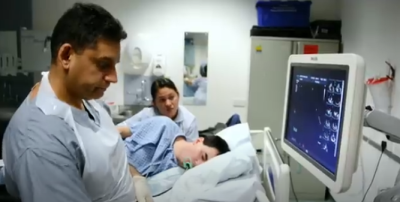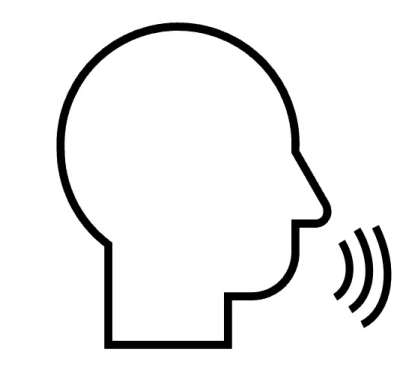Neurodiversity information for parents and young people
About a TOE
A TOE (transoesophageal echocardiogram) is an ultrasound scan that allows a doctor to look closely at the structure of your heart chambers and valves without other organs blocking the view.
To carry out the procedure, we attach a special scope (a long flexible tube) to an ultrasound machine and pass the tube through your mouth and down your throat.
The scan produces pictures of your heart which the doctor can see on a monitor.

Benefits and risks of a TOE
Benefits
The scan generates images that help us to do the following:
- find out the reasons for your symptoms
- decide if you need further procedures or treatments
- assess the function of your heart muscle and valves and look for abnormalities such as blood clot and infection.
Risks
The risks from having a TOE are low. Most people tolerate it well. You may have some mild symptoms during the investigation (mostly coughing).
Serious risks are rare and include:
- Arrhythmia (irregular heartbeat), bleeding, chest pain or difficulty breathing. Fewer than 1% of patients experience any of these.
- Oesophageal perforation (a hole in your food pipe). Fewer than 1 in 10,000 patients experience this.
Your doctor will only recommend that you have a TOE if they feel the benefits outweigh the risks. Your doctor will discuss with you any specific risks that relate to you.
Alternatives to having a TOE
Your doctor has recommended that a TOE is the most appropriate investigation for your condition. If you wish to discuss alternatives, talk to your doctor before you sign the consent form.
How to prepare for your procedure
During your pre-assessment appointment, the CNS will explain what you should bring to hospital with you on the day of the procedure. They will also tell you how to prepare for the procedure, as follows:
- If you can, we recommend you have a shower before you come to the hospital.
- Wear comfortable, loose clothing to the hospital.
- Remove all jewellery and nail varnish before you arrive.
- You can bring your phone, spectacles, and hearing aids with you.
- Bring a dressing gown, slippers and your medicines.
For detailed instructions for morning and afternoon TOE procedures, use the drop-down menus.
- If your TOE is scheduled for the morning, you can have a light breakfast before 4am.After 4 am, do not eat or drink any fluids.
- Take any medication you would normally take in the morning, unless you have been advised otherwise.
- If you take blood thinning medication, such as warfarin, apixaban, edoxaban, rivaroxaban or dabigatran, continue to take this before the procedure.
- If you take insulin, take half the dose in the morning of your procedure, instead of your usual full dose.
- Bring all your medications with you to the hospital. The nurses will look at your tablets when you are admitted. They will explain to you when you can start taking them again after the procedure.
- If your TOE is scheduled for the afternoon, you can have a light breakfast before 7am.After 7 am, do not eat or drink any fluids.
- Take any medication you would normally take in the morning, unless you have been advised otherwise.
- If you take blood thinning medication, such as warfarin, apixaban, edoxaban, rivaroxaban or dabigatran, continue to take this before the procedure.
- If you take insulin, take half the dose in the morning of your procedure, instead of your usual full dose.
- Bring all your medications with you to the hospital. The nurses will look at your tablets when you are admitted. They will explain to you when you can start taking them again after the procedure.
Important information
As this procedure involves sedation, you cannot drive yourself home afterwards.
You must arrange for someone to take you home.
You must arrange for someone responsible to stay with you for 24 hours after the procedure.
What happens when you arrive for your procedure
You can expect the following when you arrive on the day of your procedure.
- The doctor will explain the procedure to you, including the risks and benefits.
- We will ask you to sign a consent form to confirm you are happy to go ahead.
- We will give you a hospital gown to wear.
- We will attach a blood pressure cuff to your arm and put a small monitor on your finger to monitor oxygen levels in your blood.
- We will insert a small tube (cannula) into your arm so we can sedate you during the procedure. You will feel relaxed and fall asleep.

If you have concerns about the procedure, speak to the doctor, who will answer your questions.
What happens during the procedure
You can expect the following during the procedure.
- The doctor will briefly explain the procedure again. They will spray your throat with some local anaesthetic.
- A mouth guard will be placed between your teeth. This is to protect the scope (tube) and your teeth.
- We will ask you to turn onto your left side.
- We will give you sedation medicine, and when you are sleepy the doctor will start the procedure.
- Other healthcare professionals, including another doctor and a nurse, will be there to help with the procedure and make sure you are comfortable.
- When we put the tube into your mouth you may be aware of it. This depends on how sleepy you are.
- You may find that your mouth waters. This is normal, and a suction machine will be on standby to help you if needed.
- To finish the procedure, we will remove the tube quickly and easily.
- The procedure usually takes 20 to 30 minutes.

While the tube is in place, try to breathe through your nose. Do not try to talk. Do not try to swallow because this increases the risk of choking.
Professional observersThe department where your procedure will take place regularly has professional observers present. Most of these observers are healthcare professionals who are qualified or in training. Occasionally they are specialist company representatives.
|
After your procedure
You can expect the following after the procedure.
- The effects of the sedation can last for a few hours.
- The sedation has an amnesic effect (partial loss of memory) so you may not remember much about the procedure after the sedation wears off. You will probably be awake and talking within an hour, but you may not remember your conversations. This is a temporary effect of the sedation.
- We will check your blood pressure and oxygen level. We may ask you to wear an oxygen mask.
- After 1 hour, when the throat anaesthetic has worn off, we will offer you refreshments. If you are able to eat, we will give you a snack. You can get dressed when you feel able.
- The doctor will discuss the investigative results of your procedure with you.
More information
British Heart Foundation video on TOE
NHS information on day case coronary angiogram
NHS information on having a pacemaker fitted
Contact information
Cardiology Department Admin Team, Monday to Friday 9am to 5pm
or
Cardiac Nurse Specialists (CNS), Monday to Friday 9am to 5pm
or
Cardiac Catheter Laboratory and Recovery, Monday to Friday 9am to 5pm
Telephone:
Cardiology Admin: 020 8934 2321
CNS: 020 8934 6453
Cardiac Catheter Lab and Recovery: 020 8934 6413
